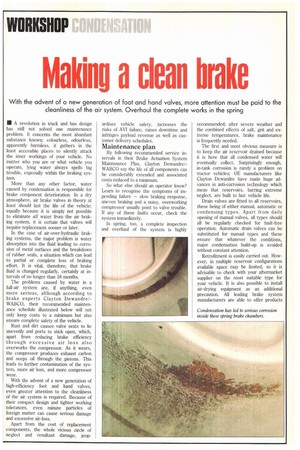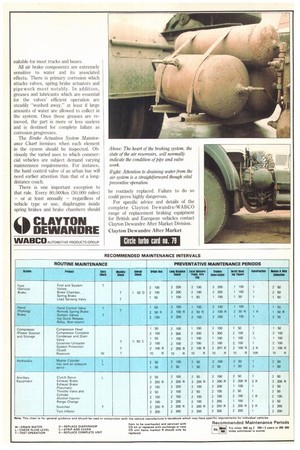Making a clean brake
Page 109

Page 110

If you've noticed an error in this article please click here to report it so we can fix it.
With the advent of a new generation of foot and hand valves, more attention must be paid to the cleanliness of the air system. Overhaul the complete works in the spring
• A revolution in truck and bus design has still not solved one maintenance problem. It concerns the most abundant substance known; colourless, odourless, apparently harmless, it gathers in the least accessible places to silently attack the inner workings of your vehicle. No matter who you are or what vehicle you operate, lying water always spells big trouble, especially within the braking system.
More than any other factor, water caused by condensation is responsible for brake component deterioration. In a dry atmosphere, air brake valves in theory at least should last the life of the vehicle; equally because it is simply not possible to eliminate all water from the air braking system, it is certain that valves will require replacement sooner or later.
In the case of air-over-hydraulic braking systems, the major problem is water absorption into the fluid leading to corrosion of metal surfaces and the breakdown of rubber seals, a situation which can lead to partial or complete loss of braking effort. It is vital, therefore, that brake fluid is changed regularly, certainly at intervals of no longer than 18 months.
The problems caused by water in a full-air system are, if anything, even more serious, although according to brake experts Clayton Dewandre/WABCO, their recommended maintenance schedule illustrated below will not only keep costs to a minimum but also ensure complete safety of the vehicle.
Rust and dirt causes valve seats to lie unevenly and ports to stick open, which, apart from reducing brake efficiency through excessive air loss also overworks the compressor. As it wears, the compressor produces exhaust carbon and seeps oil through the pistons. This leads to further contamination of the system, more air loss, and more compressor wear.
With the advent of a new generation of high-efficiency foot and hand valves, even greater attention to the cleanliness of the air system is required. Because of their compact design and tighter working tolerances, even minute particles of foreign matter can cause serious damage and excessive air-loss.
Apart from the cost of replacement components, the whole vicious circle of neglect and resultant damage, jeop
ardises vehicle safety, increases the risks of AVI failure, raises downtime and infringes payload revenue as well as customer delivery schedules.
Maintenance plan
By following recommended service intervals in their Brake Actuation System Maintenance Plan, Clayton DewandreiWABCO say the life of all components can be considerably extended and associated costs reduced to a minimum.
So what else should an operator know? Learn to recognise the symptoms of impending failure — slow braking response, uneven braking and a noisy, overworking compressor usually point to valve trouble. If any of these faults occur, check the system immediately.
In spring, too, a complete inspection and overhaul of the system is highly recommended; after severe weather and the combined effects of salt, grit and extreme temperatures, brake maintenance is frequently needed.
The first and most obvious measure is to keep the air reservoir drained because it is here that all condensed water will eventually collect. Surprisingly enough, in-tank corrosion is rarely a problem on tractor vehicles; OE manufacturers like Clayton Dewandre have made huge advances in anti-corrosion technology which mean that reservoirs, barring extreme neglect, are built to last vehicle life.
Drain valves are fitted to all reservoirs, these being of either manual, automatic or condensing types. Apart from daily opening of manual valves, all types should all be regularly checked for fault-free operation. Automatic drain valves can be substituted for manual types and these ensure that whatever the conditions, major condensation build-up is avoided without constant attention.
Retrofitment is easily carried out. However, in multiple reservoir configurations available space may be limited, so it is advisable to check with your aftennarket supplier on the most suitable type for your vehicle. It is also possible to install air-drying equipment as an additional precaution. All leading brake system manufacturers are able to offer products suitable for most trucks and buses.
All air brake components are extremely sensitive to water and its associated effects. There is primary corrosion which attacks valves, spring brake actuators and pipework most notably. In addition, greases and lubricants which are essential for the valves' efficient operation are steadily "washed away," at least if large amounts of water are allowed to collect in the system. Once those greases are removed, the part is more or less useless and is destined for complete failure as corrosion progresses.
The Brake Actuation System Maintenance Chart itemises when each element in the sysem should be inspected. Obviously the varied uses to which commercial vehicles are subject demand varying maintenance requirements. For instance, the hand control valve of an urban bus will need earlier attention than that of a longdistance coach.
There is one important exception to that rule. Every 80,000km (50,000 miles) — or at least annually — regardless of vehicle type or use, diaphragms inside spring brakes and brake chambers should be routinely replaced. Failure to do so could prove highly dangerous.
For specific advice and details of the complete Clayton Dewandre/WABCO range of replacement braking equipment for British and European vehicles contact Clayton Dewandre After Market Division.
Clayton Dewandre After Market
















































































































